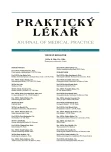The Newborn Scale of Sepsis questionnaire – the Czech version (SOS-CZ) for evaluating the risk of sepsis in newborns
Authors:
P. Rabasová; L. Sikorová
Authors‘ workplace:
Děkan: doc. MUDr. Arnošt Martínek, CSc., Ústav ošetřovatelství a porodní asistence, Vedoucí: doc. PhDr. Darja Jarošová, Ph. D.
; Ostravská Univerzita v Ostravě, Lékařská fakulta
Published in:
Prakt. Lék. 2012; 92(10-12): 558-562
Category:
Of different specialties
Overview
According to NANDA International (North American Nursing Diagnosis Association), it is necessary to use standardized and valid evaluation tools for more precise detection of infection (sepsis) in newborns. On the basis of a review in selected hospitals it has been determined that nurses had no questionnaire available for sepsis risk evaluation in newborns. The reason is the absence of a sepsis sign assessment method (scale) for newborns in Czech written records. The ever increasing need for professional care of child patients using the most efficient tests and scales for accurate nursing diagnostics with subsequent relevant interventions, offers the possibility for objectivising the determined nursing diagnoses according to NANDA-Int. in newborns. The article presents the results of the systematic analysis of literature resources, professional licensed and freely accessible databases, about the current possibilities for sepsis risk evaluation in newborns by means of scoring systems. The text also aims at introducing the Czech version of the Newborn Scale of Sepsis (SOS-CZ) questionnaire for evaluating sepsis risk in newborns.
Key words:
scale, sepsis, newborn, evaluation
Sources
1. Marečková, J.: Ošetrovatelské diagnózy v NANDA doménách. Praha: Grada Publishing 2006, s. 17.
2. Herdman, T. H.: NANDA International Ošetrovatelské diagnózy: Definice & klasifikace 2009-2011. Praha: Grada Publishing 2010. s. xxi.
3. Sikorová, L.: Hodnotící metody pro ošetřovatelskou diagnostiku v domácí péči. In: Jarošová, D. a kol. Využitelnost ošetřovatelských klasifikací NANDA International a NIC v domácí péči. Ostrava: OU 2012: s. 61–85.
4. Černá, O., Pokorná, P., Sádlo, M.: Sepse v dětském věku. Klin Farmakol Farm 2008; 22(1): s. 34–39.
5. Pokorný, J.: Urgentní medicína. Praha: Galén 2004, s. 397–398.
6. Muntau, C. A.: Pediatrie. Praha: Grada Publishing 2009, s. 30–31.
7. Ševčík, P. a kol.: Intenzivní medicína. Praha: Galén 2003, s. 107.
8. Kapounová, G.: Ošetřovatelství v intenzivní péči. Praha: Grada Publishing 2007, s. 42.
9. Gut, J., Hoza, J.: Horečka u dětí. Pediatr. pro Praxi. 2004; 5(2): s. 99–102.
10. Bouček, J. a kol.: Lékařská psychologie. Olomouc: UP v Olomouci 2006, s. 16.
11. Plevová, I., Slowik, R.: Komunikace s dětským pacientem. Praha: Grada Publishing 2010, s. 76.
12. Fendrychová, J. a kol.: Péče o kriticky nemocné dítě. Brno: NCO NZO 2005, s. 80.
13. Rubarth, B. L.: Nursing patterns of knowing in assessment of newborn sepsis. A Dissertation. The University of Arizona. 2005, p. 174, 122. [cit. 2012-15-04]. Dostupný z WWW: http://www.nursing.arizona.edu/Library/Rubarth_LB.pdf.
14. Gardner, S. L.: Sepsis in the neonate. Critical care nursing clinics of North America 04/2009; 21(1):121-41, vii. DOI:10.1016/j.ccell.2008.11.002. [cit. 2012-28-11]. Dostupný z WWW: http://researchgate.net/publication/24034763_Sepsis_in_the_neonate.
Labels
General practitioner for children and adolescents General practitioner for adultsArticle was published in
General Practitioner

2012 Issue 10-12
- Advances in the Treatment of Myasthenia Gravis on the Horizon
- What Effect Can Be Expected from Limosilactobacillus reuteri in Mucositis and Peri-Implantitis?
- Hope Awakens with Early Diagnosis of Parkinson's Disease Based on Skin Odor
- Metamizole in perioperative treatment in children under 14 years – results of a questionnaire survey from practice
- Memantine Eases Daily Life for Patients and Caregivers
Most read in this issue
- Haemorrhoids and their treatment
- Sex life of seniors living in social service homes
- Primary care and health promotion in the Czech Republic
- Anonymous donation of gametes and anonymous births: common ethical, psychosocial and legal aspects
